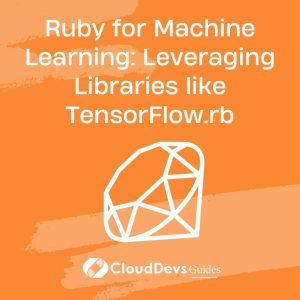Ruby for Machine Learning: Leveraging Libraries like TensorFlow.rb
In the realm of machine learning, programming languages like Python have often taken the spotlight due to their extensive libraries and frameworks tailored for the field. However, there’s another language that’s been steadily gaining ground in the world of machine learning: Ruby. Ruby, known for its elegant syntax and ease of use, might not be the first language that comes to mind for machine learning tasks, but with the emergence of libraries like TensorFlow.rb, its potential is becoming more evident than ever.
Table of Contents
1. The Unconventional Duo: Ruby and Machine Learning
When thinking about machine learning, languages like Python and R often dominate the conversation. Python, with its rich ecosystem of libraries like TensorFlow, PyTorch, and scikit-learn, has become the de facto choice for many machine learning practitioners. R, known for its statistical prowess, is also a popular choice, especially in academic and research settings. However, Ruby, despite its reputation as a versatile scripting language, hasn’t historically been associated with machine learning.
This is where the concept of TensorFlow.rb enters the scene. TensorFlow.rb bridges the gap between the TensorFlow library and the Ruby programming language, making it possible to tap into the power of TensorFlow while working within the Ruby environment. This combination offers the best of both worlds: the expressiveness of Ruby and the robustness of TensorFlow.
2. Introducing TensorFlow.rb
TensorFlow, developed by Google, is one of the most widely used open-source machine learning libraries. Its popularity stems from its flexibility, scalability, and ease of use. TensorFlow supports a wide range of machine learning tasks, from building neural networks to training complex models. With TensorFlow.rb, Ruby developers can now leverage the capabilities of TensorFlow without having to switch to another programming language.
Let’s take a look at a simple example to understand how TensorFlow.rb works:
2.1. Installing TensorFlow.rb
Before we dive into the example, let’s ensure we have TensorFlow.rb installed. You can install it using the following command:
ruby gem install tensorflow
2.2. Creating a Basic Neural Network
In this example, we’ll create a basic neural network using TensorFlow.rb to classify handwritten digits from the MNIST dataset. First, let’s import the necessary modules and prepare the dataset:
ruby require 'tensorflow' # Load the MNIST dataset mnist = TensorFlow::Keras.datasets.mnist (train_images, train_labels), (test_images, test_labels) = mnist.load_data # Normalize pixel values to a range of 0 to 1 train_images = train_images / 255.0 test_images = test_images / 255.0
Now, let’s define the architecture of our neural network:
ruby
model = TensorFlow::Keras.models.Sequential([
TensorFlow::Keras.layers.Flatten(input_shape: [28, 28]),
TensorFlow::Keras.layers.Dense(units: 128, activation: 'relu'),
TensorFlow::Keras.layers.Dropout(0.2),
TensorFlow::Keras.layers.Dense(units: 10, activation: 'softmax')
])
model.compile(optimizer: 'adam',
loss: 'sparse_categorical_crossentropy',
metrics: ['accuracy'])
With the architecture defined, we can now train and evaluate our model:
ruby
model.fit(train_images, train_labels, epochs: 5)
test_loss, test_acc = model.evaluate(test_images, test_labels)
puts "Test accuracy: #{test_acc}"
This example showcases the seamless integration of TensorFlow functionality within Ruby code. From loading data to defining the neural network architecture and training the model, all the steps are executed within the Ruby environment.
3. Advantages of Using Ruby for Machine Learning
While Ruby might not be the most conventional choice for machine learning, it offers several advantages that make it worth considering:
- Elegant Syntax: Ruby’s clean and expressive syntax makes it easy to read and write code. This can lead to more concise and maintainable machine learning code.
- Developer-Friendly: Ruby’s focus on developer happiness translates well into the machine learning domain. Developers familiar with Ruby can quickly adapt to writing machine learning code in a comfortable environment.
- Full-Stack Capabilities: Many machine learning projects involve integrating with web applications or other parts of a software ecosystem. Ruby’s versatility allows developers to seamlessly integrate machine learning components into larger applications.
- Rapid Prototyping: Ruby’s dynamic nature enables rapid prototyping of machine learning models. Experimenting with different approaches and ideas becomes smoother and faster.
- Community and Libraries: Although Ruby’s machine learning ecosystem is still growing, the community’s enthusiasm has led to the development of libraries like TensorFlow.rb, expanding Ruby’s capabilities in the machine learning landscape.
4. Getting Started with TensorFlow.rb
To start your journey with TensorFlow.rb, follow these steps:
- Install TensorFlow.rb: Begin by installing the TensorFlow.rb gem using the command mentioned earlier: gem install tensorflow.
- Explore TensorFlow.rb Documentation: Familiarize yourself with the TensorFlow.rb documentation and examples. The documentation provides insights into various features and functions.
- Experiment with Examples: Experiment with machine learning examples using TensorFlow.rb. Start with simple models and gradually move on to more complex tasks.
- Join the Community: Engage with the growing TensorFlow.rb community. Participate in forums, discussions, and open-source projects to learn from others and share your experiences.
Conclusion
Ruby’s entry into the machine learning arena, coupled with libraries like TensorFlow.rb, offers an exciting opportunity for developers and researchers to explore new horizons. While it might not be the most conventional choice, Ruby’s elegant syntax and the power of TensorFlow can synergize to create effective and efficient machine learning solutions. Whether you’re a Ruby enthusiast or a machine learning practitioner looking to expand your skill set, TensorFlow.rb opens the door to a world where Ruby and machine learning work hand in hand to push boundaries and innovate. So why not embark on this journey and unlock the potential of Ruby in the realm of machine learning?
Table of Contents








